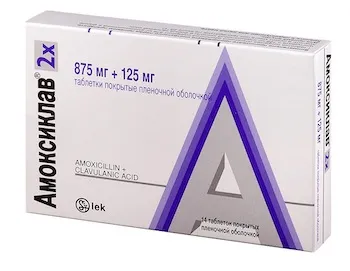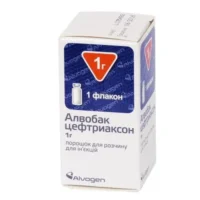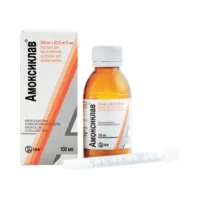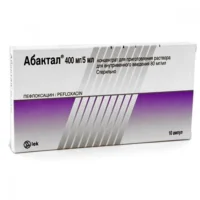Description
Amoxiclav (Amoxicillin) Coated Tablets 875 mg/125 mg. №14
Ingredients
Each tablet contains 875 mg of amoxicillin and 125 mg of clavulanic acid.
Mechanism of Action
Amoxiclav is a combination antibiotic that works by inhibiting the synthesis of bacterial cell walls. The amoxicillin component interferes with the formation of peptidoglycan layer, while clavulanic acid prevents bacterial enzymes from degrading amoxicillin, thus extending its spectrum of activity.
Pharmacological Properties
Amoxiclav exhibits bactericidal activity against a wide range of gram-positive and gram-negative bacteria. The combination of amoxicillin and clavulanic acid enhances the efficacy of amoxicillin against beta-lactamase-producing bacteria, making it effective against resistant strains.
Indications for Use
Amoxiclav is indicated for the treatment of various bacterial infections, including respiratory tract infections, urinary tract infections, skin and soft tissue infections, otitis media, and sinusitis. It is also used in dental infections and prophylaxis during certain surgical procedures.
Contraindications
Avoid using Amoxiclav if you have a history of allergic reactions to penicillin or cephalosporin antibiotics. Inform your healthcare provider about any known allergies before starting this medication to prevent severe hypersensitivity reactions.
Side Effects
Common side effects of Amoxiclav may include diarrhea, nausea, vomiting, skin rash, and allergic reactions. In rare cases, it can lead to severe adverse effects such as liver dysfunction or pseudomembranous colitis. Contact your doctor if you experience any unusual symptoms while taking this medication.
Usage Instructions
Take one tablet of Amoxiclav (875 mg/125 mg) every 12 hours with a full glass of water. Do not crush or chew the tablet. Follow the dosage regimen prescribed by your healthcare provider for the complete duration of treatment to ensure optimal therapeutic outcomes.
Benefits Compared to Analogues
Amoxiclav offers a broader spectrum of antibacterial activity compared to traditional amoxicillin formulations due to the addition of clavulanic acid. This combination helps combat bacterial resistance mechanisms, making it a preferred choice for treating complex infections.
Suitable Patient Groups
Amoxiclav is generally safe for use in adults, children, and elderly patients when administered at appropriate doses. Dosage adjustments may be required in individuals with renal impairment to prevent drug accumulation and toxicity. Consult a healthcare professional for personalized dosing recommendations based on individual patient factors.
Storage and Shelf Life
Store Amoxiclav in a cool, dry place away from direct sunlight and moisture. Keep the tablets in their original packaging to protect them from environmental factors. Check the expiration date on the package and do not use the medication beyond the stated shelf life to ensure potency and safety.
Packaging Description
Amoxiclav tablets are supplied in blister packs containing 14 coated tablets. Each tablet is imprinted with the dosage strength for easy identification. The packaging should be intact and undamaged before use to guarantee product quality.
Scientific Evidence
Amoxiclav, a combination of amoxicillin and clavulanic acid, has been extensively studied for its efficacy in treating bacterial infections. Research has shown that the addition of clavulanic acid enhances the activity of amoxicillin against beta-lactamase-producing bacteria, making it a potent antibiotic combination.
Additional Information
Completing the full course of Amoxiclav as prescribed is crucial to prevent the development of antibiotic resistance. Even if symptoms improve, continue taking the medication until the recommended duration to eradicate the infection completely.
Prior to initiating Amoxiclav therapy, inform your healthcare provider about any existing medical conditions and ongoing medications to avoid potential drug interactions or adverse effects. Regular monitoring during treatment can help ensure therapeutic efficacy and safety.





